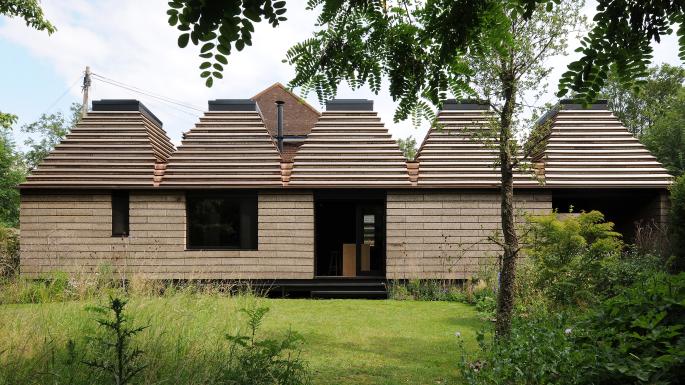Cork House shows potential for sustainable ‘near-zero’ construction
A ground-breaking experimental house constructed using cork and other plant-based materials, is a contender for best new building in the UK.
Cork House in Berkshire is on the six-strong shortlist for the 2019 RIBA Stirling Prize which will be announced on October 8th at the Roundhouse in London.
It is a stunningly impressive design and shows what is possible in truly sustainable construction while challenging architects to think more deeply about “whole life sustainability” of the buildings they create, from design to demolition.
It was designed, tested and developed by Matthew Barnett Howland, Dido Milne and Oliver Wilton in a six-year project, in partnership with The Bartlett School of Architecture at University College London and engineers Arup.


Core design
The architectural team are keen to emphasise the urgent need to reshape the culture of building design for the Post-carbon Age. Currently, buildings are responsible for 40% of global greenhouse gas emissions, yet too often the “whole life” sustainability of new builds is not part of the core design processes.
The Thames riverside building is almost entirely constructed using cork blocks, apart from some timber, structural beams and glass windows. Being seen as a trail-blazing, first of a kind home, it has solid structural cork walls and roof.
Every component has been designed to be reused or recycled and the house was carbon negative on completion and it emits next to zero carbon. The expanded cork blocks were made from by-products and waste from cork forestry and the cork stopper industry.
Cork House has been compared to a “giant, organic Lego system” with easy assembly, and it can be just as easily disassembled. The design team planned it as a kit form, with the blocks of expanded cork prefabricated offsite and then assembled by hand without using glue or mortar.
By-product and waste
All the components can be reused or recycled, and the expanded cork blocks were made using by-product and waste from cork forestry and the cork stopper industry.
A neglected construction product, cork is strong when compressed while being a great insulator with excellent water resistance. The cork oak tree bark is harvested by hand every nine to 12 years and the tree is left intact for further growth, rather than being felled.
Currently, much of the harvested cork is used to make corks for wine bottles and Portugal and Spain are responsible for 80% of production.
Cork House, with an internal area 44 m² has already won the RIBA South Award 2019, the RIBA South Sustainability Award 2019 and the RIBA National Award 2019.
It is up against a very strong field for the Stirling Prize, including an opera house, a distillery, social housing and London Bridge station.
The judges say:
“Designed with immense attention to detail, Cork House is a structure of great ingenuity. Sited within the area of a Grade II Listed mill house dating back to the early nineteenth century, the Cork House beautifully reflects and respects the natural surroundings in form and construction.
“The structure draws upon ancient inspiration, harking back to a time when humans and nature were more intertwined.”
Architect Matthew Barnett Howland says:
“It’s a provocation, to some extent. We’re not saying that cork is the answer to the construction industry’s problems, but it does point up the need to think about a whole-life approach to buildings.”
Whether it triumphs on October 8th or not, the Cork House should help to reshape the key models that will inform architectural practise, both in the UK and globally, making whole life sustainability a central focus.
Subscribe to Learn&Save
Sustainability tips and news straight to your inbox